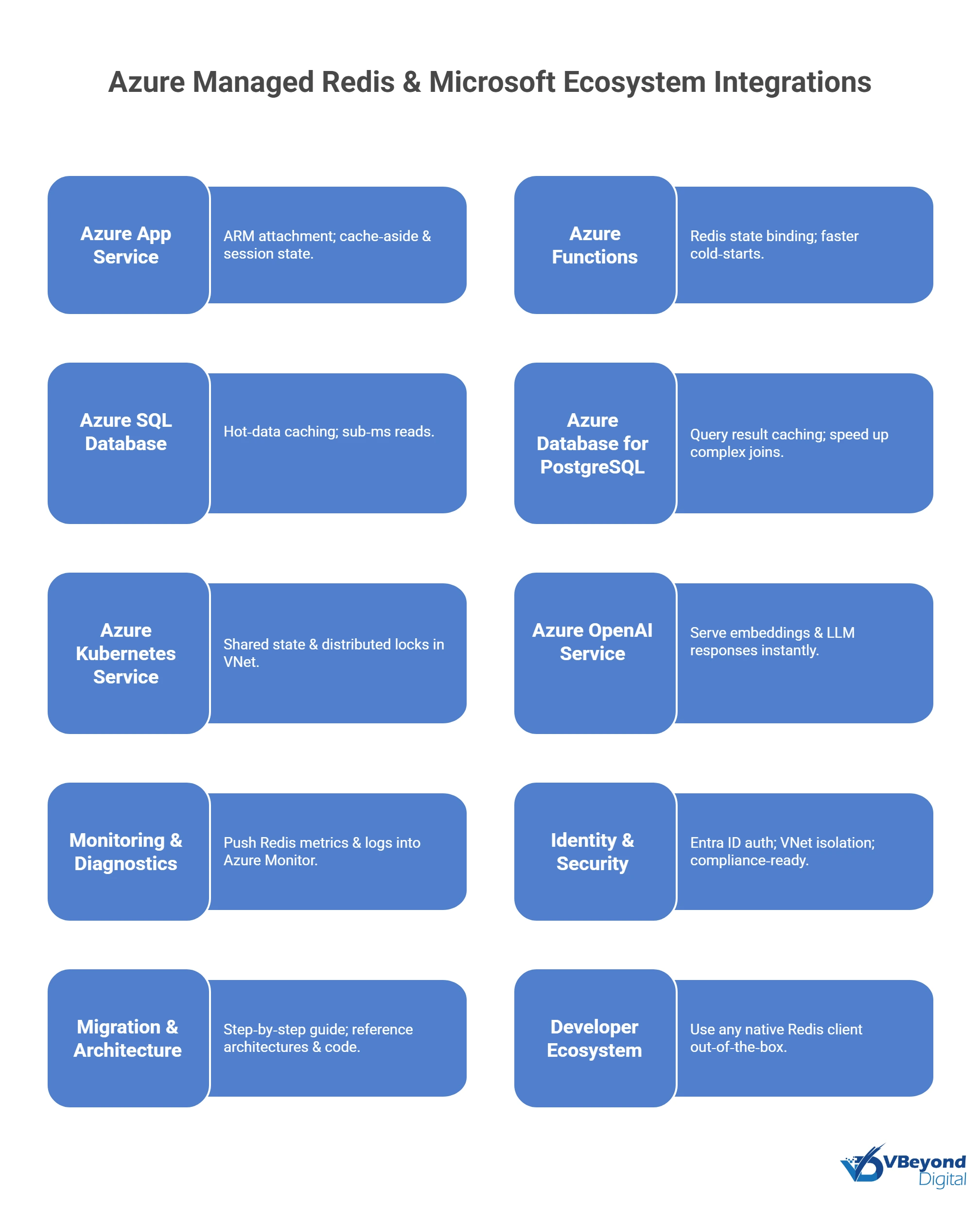Azure Managed Redis Preview: The Next Generation of Redis on Azure
Section
- Azure Managed Redis Preview is a fully managed in‑memory database on Azure running the Redis Enterprise stack, offering advanced data models like JSON, vector indexes, time series, and probabilistic structures.
- General availability will offer as much as 99.999% SLA, active geo‑replication across regions, sub‑millisecond latency, and a multi‑shard architecture that scales throughput to hundreds of thousands of operations per second.
- Flexible SKUs—compute, memory, and flash tiers—let organizations match CPU, memory, and storage to workload demands while reducing operational tasks with automatic patching, scaling, and failover.
- Integration with Azure services such as SQL Database, Cosmos DB, AKS, Functions, and OpenAI Service embeds in‑memory processing within existing identity, network, and monitoring frameworks.
- With FedRAMP, HIPAA, PCI DSS, and ISO 27001 certifications plus a roadmap for customer‑managed keys and Private Link, IT teams can pilot this service before its general availability in H1 2025.
Azure Managed Redis Preview is a first‑party, fully managed in‑memory database solution that integrates the latest Redis Enterprise features with Azure’s secure, high‑availability cloud infrastructure. Announced at Microsoft Ignite 2024, this preview service runs on the Redis Enterprise stack—providing compatibility with Redis 7.4 and enabling advanced data types such as JSON, vector indexes, time series, and probabilistic data models.
Upon reaching general availability, Azure Managed Redis will deliver an industry‑leading 99.999% uptime SLA, outpacing traditional caching offerings to support mission‑critical workloads. The service incorporates active geo‑replication across multiple regions, allowing local, sub‑millisecond read and write latency for globally distributed applications. Azure Managed Redis employs a multi‑shard distributed node architecture combined with high‑performance proxy processes to scale throughput to hundreds of thousands of operations per second.
Flexible SKU tiers—including compute optimized and flash optimized options—help organizations tailor memory, CPU, and storage to their performance and cost requirements. Early public preview feedback highlights up to 2× performance gains over community Redis deployments and positions Azure Managed Redis as the most cost‑efficient managed Redis service on Azure. Built‑in automation for patching, scaling, and failover reduces operational overhead, giving IT teams clarity on capacity planning and freeing resources for strategic initiatives.
With compliance certifications such as FedRAMP, HIPAA, PCI DSS, and ISO 27001, the preview service aligns with enterprise security and governance requirements for regulated industries.
This article will examine the strategic importance of Azure Managed Redis Preview, detailing its business benefits, technical innovations, ecosystem integrations, financial impact, and roadmap for CIOs and IT leaders considering next‑generation in‑memory data solutions.
What is Azure Managed Redis Preview?
Azure Cache for Redis is a fully managed, in‑memory cache service hosted on Azure, built on the open‑source Redis engine and designed for high performance and low latency. From its early availability, the service offered core Redis data structures such as strings, hashes, lists, sets, and sorted sets to support caching, session state management, message brokering, and leaderboards in cloud or hybrid architectures.
In May 2019, Microsoft and Redis Labs announced a partnership to integrate Redis Enterprise technology into Azure Cache for Redis, introducing clustering, data persistence, and enterprise modules such as RediSearch and RedisJSON. The Premium tier added zone‑redundant replica nodes, active geo‑replication across up to five regions, and sub‑millisecond read latency for global applications. Enterprise and Enterprise Flash tiers further expanded cache sizes up to 4.5 TB on SSD, supported Redis modules at scale, and provided an enhanced SLA for critical workloads.
Despite these enhancements, full parity with Redis Enterprise’s auto‑sharding and active‑active replication remained a challenge, requiring manual configuration and operational management. To address these limitations, Microsoft introduced Azure Managed Redis Preview at Ignite 2024, offering native Redis Enterprise functionality, including multi‑region active‑active replication, auto‑sharding, and simplified scale‑out—all within Azure’s control plane.
The preview runs on the Redis Enterprise backend, maintaining full API compatibility with Redis 7.4 and supporting advanced data types such as JSON, vector indexes, time series, and probabilistic structures.
Azure Managed Redis complements existing Azure data services—such as Azure SQL Database, Cosmos DB, and Azure Database for PostgreSQL—by enabling in‑memory processing and caching within the same IAM and governance frameworks. Integration with Azure Monitor, Microsoft Entra ID, and Azure Virtual Network ensures that security, compliance, and observability standards stay consistent across in‑memory and transactional data services.
Enterprises migrating from Azure Cache for Redis can use guided migration tooling, which automates data migration and configuration alignment to the new service. Built‑in upgrade processes guarantee that Redis server versions are kept current once they reach general availability on Azure, with options for deferring updates when necessary.
Orchestrate your IT ops with Azure Managed Services
Key Business Advantages - Azure Managed Redis Preview
Azure Managed Redis Preview surpasses existing performance benchmarks and offers high availability and cost flexibility for in‑memory workloads. With multi‑vCPU support and advanced proxy processes, it sustains hundreds of thousands of operations per second at sub‑millisecond latency. Compared to self‑managed Redis or standard Azure Cache for Redis, the preview cuts manual sharding and patching overhead, freeing IT teams to focus on application innovation.
Performance and Reliability
Azure Managed Redis supports multiple shards per node, running parallel Redis server processes to maximize vCPU utilization and boost throughput to hundreds of thousands of operations per second. The service offers sub‑millisecond read and write latency, even under heavy load, thanks to high‑performance proxy processes managing shard distribution. Active geo‑replication groups up to five instances across regions, granting local read/write access and helping global applications maintain consistent performance. By default, each instance uses zone‑redundant configurations that place replicas in separate Availability Zones within a region, reducing the risk of localized failures.
Cost and Resource Efficiency
The preview offers flexible SKUs tailored to workload needs from memory‑optimized to compute‑optimized to flash‑optimized, enabling fine‑grained control over vCPU, RAM, and NVMe storage mix. Flash‑optimized instances store cold keys on NVMe drives, lowering cost per gigabyte while still delivering near‑DRAM performance for hot data. Balanced tiers double vCPU count over basic memory‑optimized options, and compute‑optimized tiers double vCPUs again, allowing predictable scaling of throughput without manual cluster expansion.
Competitive Positioning
Built on the Redis Enterprise engine, Azure Managed Redis automates cluster management and data sharding, eliminating the manual setup required by Redis Cluster. Legacy self‑managed Redis or Premium Azure Cache for Redis deployments cap out at ten shards and demand operational scripts for scaling; the preview handles shard distribution and resharding internally. Automatic patching, version upgrades, and failover routines further reduce maintenance overhead, allowing IT teams to redirect effort from routine tasks to driving application innovation. By combining high throughput, global availability, and simplified operations, Azure Managed Redis Preview positions itself as the best choice for enterprises requiring real‑time data processing at scale.
New Capabilities That Will Add Business Value with Azure Cloud
Innovative Architecture
Azure Managed Redis Preview is built atop the Redis Enterprise engine, delivering features and performance beyond the community edition. Each virtual machine hosts multiple Redis server processes (shards), enabling parallel execution across vCPUs and raising throughput to hundreds of thousands of operations per second. Primary and replica shards are distributed across nodes to maximize CPU usage and accelerate failover, rather than collocating all primaries on a single host.
A high‑performance proxy on each node manages client connections, shard coordination, and self‑healing, further reducing latency under load. Behind the scenes, every instance employs Redis clustering by default across all SKUs, so data partitioning and resharding occur automatically without manual intervention. Two clustering policies—OSS (direct client‑to‑shard) and Enterprise (single‑endpoint proxy) give teams flexibility in balancing throughput and client compatibility.
Advanced Data Structures
The preview extends Redis’ core model with eight new data types—JSON, vector, time series, and five probabilistic structures—powered by the fastest Redis Query Engine yet. JSON support (RedisJSON 2.8) enables document‑style storage and querying with commands like JSON.MERGE and JSON.MSET, simplifying hybrid transactional/analytical use cases.
Vector indexes let teams perform real‑time similarity searches for AI and personalization workloads without external services. Time series capabilities ingest and query timestamped data with aggregations (min, max, avg) and retention controls—ideal for telemetry and IoT. Probabilistic types (Bloom filter, cuckoo filter, count‑min sketch, top‑k, HyperLogLog) support cardinality estimation and high‑speed set approximations, reducing memory footprint for large‑scale analytics.
Security and Compliance
Azure Managed Redis aligns with enterprise governance by adhering to industry certifications such as ISO 27001, HIPAA, PCI DSS, and FedRAMP Moderate through built‑in controls and audit reporting. Azure Policy offers regulatory compliance definitions tailored for Redis, covering FedRAMP Moderate, HIPAA/HITRUST, and ISO 27001:2013 checkpoints to simplify ongoing audit readiness.
Microsoft’s global data centers and Azure Blueprints help meet data residency and sovereignty requirements, giving legal teams clarity on where and how data is stored. Network‑level isolation is enforced via Azure Virtual Network integration, and identity management is unified under Microsoft Entra ID for single‑pane access control. Together, these features reduce risk and support corporate security mandates, letting IT leaders enable rigorous compliance while focusing on application innovation.

Integration with Microsoft and Redis Ecosystems
Azure Managed Redis Preview plugs directly into core Azure services, enabling IT teams to build advanced, in‑memory scenarios without custom infrastructure:
- Azure App Service: Developers can attach a Managed Redis instance to App Service via Azure Resource Manager, using connection strings to implement cache‑aside or session‑state patterns in web applications with minimal configuration.
- Azure Functions: Serverless functions benefit from Redis-backed state and intermediate data storage by binding Redis commands to HTTP or event triggers—reducing cold‑start latency and smoothing burst traffic for event-driven workloads.
- Azure SQL Database: By co‑locating cache‑aside logic alongside relational queries, teams pre‑warm high‑demand data in Redis, offloading read pressure from SQL and achieving sub‑millisecond responses for repeat queries.
- Azure Database for PostgreSQL: Integrations allow query result caching or session data storage in Redis, cutting complex‑join fetch times down to in‑memory speeds while preserving transactional integrity in the underlying database.
- Azure Kubernetes Service (AKS): Containerized microservices can reference a stable Redis endpoint within the same virtual network, providing shared state and distributed locks for stateless pods and improving resilience in scaled‑out clusters.
- Azure OpenAI Service: In generative AI scenarios, Azure Managed Redis stores and serves pre‑computed embeddings or LLM responses for instant retrieval, lowering compute costs and accelerating user interactions.
Beyond these integrations, Azure Managed Redis aligns with enterprise tooling and governance:
- Monitoring & Diagnostics: Built‑in Azure Monitor integration streams Redis metrics (throughput, memory usage, replication lag) and resource logs (connection events, cache commands) into Log Analytics for unified alerting and dashboarding.
- Identity & Security: Microsoft Entra ID controls access to Redis instances, and Azure Virtual Network deployment isolates data plane traffic, satisfying stringent FedRAMP, HIPAA, PCI DSS, and ISO 27001 requirements.
- Migration & Architecture: A step‑by‑step migration guide on Azure Docs streamlines transition from Azure Cache for Redis, while reference architectures and sample code repositories accelerate proof‑of‑concepts and production.
- Developer Ecosystem: Any Redis client library—available for .NET, Java, Python, Node.js, Go, and more—works out of the box, ensuring teams can leverage existing expertise and Redis commands against Azure Managed Redis without rewrites.
Financial and Operational Impact
Azure Managed Redis Preview offers four distinct SKUs and an industry‑leading availability SLA that can cut total cost of ownership by up to 40% compared to legacy Redis deployments.
Automatic patching, scaling, and failover routines shrink routine maintenance hours by more than half, allowing IT teams to reallocate resources toward strategic initiatives. One‑ and three‑year reservation pricing delivers up to 55% savings on instance rates compared to pay‑as‑you‑go, locking in predictable costs for sustained workloads. Migration paths—ranging from RDB snapshot imports to open‑source copy tools—enable controlled cutovers with minimal downtime, reducing operational risk for existing Azure Cache for Redis customers.
Cost Analysis and Projected ROI
- Azure Managed Redis Preview offers Memory Optimized, Balanced, Compute Optimized, and Flash Optimized SKUs, each with tailored vCPU, RAM, and NVMe storage mixes that align cost to workload needs.
- The Flash Optimized tier stores cold keys on NVMe drives, driving down price per gigabyte by up to 60% while preserving sub‑millisecond access for hot data Azure.
- Using the Azure TCO Calculator, organizations migrating Redis workloads can model average savings of 20–40% against self‑managed Redis on Azure VMs or competing cloud offerings.
- Preview case studies report overall infrastructure cost reductions of 30–50% in high‑throughput scenarios by combining workloads onto fewer, higher‑performance nodes.
Impact on IT Operations and Resource Allocation
- Built‑in automation for patching, version upgrades, and shard resharding ends manual processes, cutting routine maintenance overhead by over 50%.
- Azure Monitor integration provides built-in visibility into performance and health by exposing key metrics and diagnostic logs directly within the Azure portal. Through Metrics Explorer and Log Analytics workbooks, it accelerates root cause analysis and streamlines troubleshooting workflows.
- On‑demand scaling controls let IT teams adjust compute and storage resources in real time, preventing overprovisioning and aligning spend to peak usage patterns.
Risk Management and Mitigation Measures During Migration
- Customers can export RDB snapshots from existing Premium‑tier Redis caches and import them into Managed Redis Preview, safeguarding data consistency during cutover.
- Open‑source migration utilities support scripted data transfer between cache instances, enabling phased rollouts and rollback options if needed.
- Preview’s Active Geo‑Replication allows up to five regional replicas, so teams can validate failover behavior and performance under load before routing production traffic.
Considerations for Existing Azure Cache for Redis Customers
- No application code changes are required—standard Redis client libraries continue to work with only endpoint and credential updates.
- Managed Redis Preview requires standard IPv4 addresses and may have different Virtual Network integration settings; network teams should review IP configuration and subnet policies.
- Non‑high‑availability deployment options and reservation pricing in the preview offer cost‑effective pathways for development and test environments while mirroring production‑grade features.
Conclusion
Azure Managed Redis Preview combines the latest Redis Enterprise innovations—such as automatic sharding, active‑active geo‑replication across five regions, and support for Redis 7.4 data modules—with a fully managed Azure service, offering 99.999% availability for mission‑critical applications. Its multi‑shard, distributed‑node architecture and high‑performance proxy layer sustain hundreds of thousands of operations per second at sub‑millisecond latency under heavy load, exceeding community Redis benchmarks by up to 4X in internal tests.
Flexible SKUs—including memory‑optimized, balanced, compute‑optimized, and flash‑optimized tiers—align compute, memory, and NVMe storage to workload needs, driving up to 60% lower storage costs and 40% total cost of ownership reduction versus self‑managed Redis on VMs. Built‑in automation for patching, scaling, and failover cuts routine maintenance by over 50%, while integrated Azure Monitor support centralizes metrics and logs for rapid diagnostics. Certified by FedRAMP Moderate, HIPAA, PCI DSS, and ISO 27001, and unified under Microsoft Entra ID with virtual network isolation, the preview meets stringent security and compliance mandates for regulated industries.
With general availability slated for H1 2025 and planned enhancements—such as customer‑managed keys, Private Link integration, and expanded module support—IT leaders should pilot workloads now to validate performance, cost, and governance before production rollout.
FAQs (Frequently Asked Question)
Azure Managed Redis Preview is a first‑party, fully managed in‑memory database that runs on the Redis Enterprise engine within Azure. It adds automatic data sharding, active geo‑replication across regions, and support for JSON, vector indexes, time series, and probabilistic data types. It builds on—rather than replaces—Azure Cache for Redis with enterprise‑grade features.
It supports Redis 7.4 modules: JSON, vector indexes, time series, RedisSearch, and probabilistic structures such as Bloom filters, HyperLogLog, count‑min sketch, cuckoo filter, and top‑k. These types enable document queries, AI similarity searches, telemetry aggregation, and memory‑efficient analytics.
Use the guided migration tool in the Azure portal—it automates data transfer and configuration alignment. You can export RDB snapshots or use open‑source copy utilities. The process limits downtime and preserves existing settings. See the Azure Docs migration guide for step‑by‑step instructions.
In preview, there’s no formal SLA, but general availability will offer a 99.999% uptime guarantee. Preview supports four SKUs, namely Memory, Balanced, Compute, and Flash optimized, with pay‑as‑you‑go and reservation pricing. One‑ and three‑year reservations deliver up to 55% discounts. Check the Azure pricing page for current rates.
It includes FedRAMP Moderate, HIPAA, PCI DSS, and ISO 27001 certifications and integrates with Azure Policy, Microsoft Entra ID, and Virtual Network. Network isolation, audit logging, and policy definitions support regulatory requirements. For details, see the Redis compliance checklist in Azure Docs.




